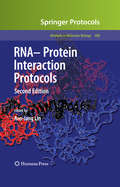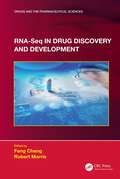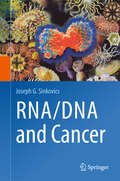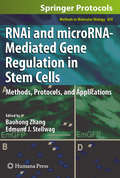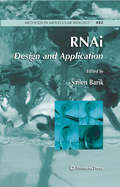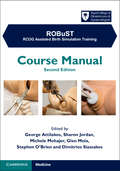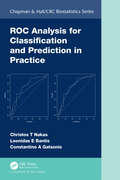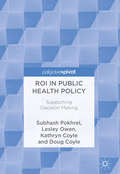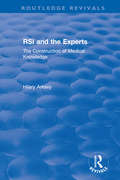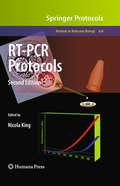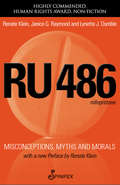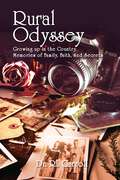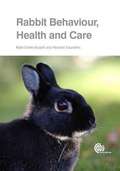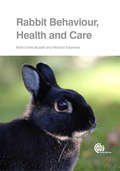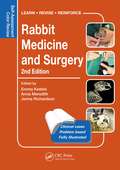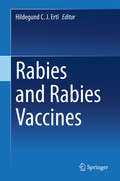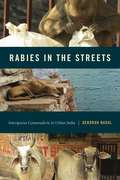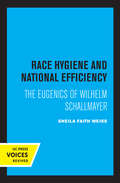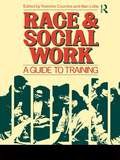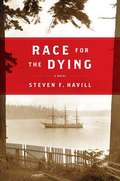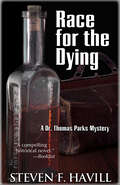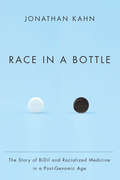- Table View
- List View
RNA-Protein Interaction Protocols
by Ren-Jang LinDue to the vital biological importance of RNA and proteins functioning together within a cell, a protocol volume describing experimental procedures to study their interactions should find a home in many laboratories. RNA-Protein Interaction Protocols, Second Edition updates, complements, and expands upon the popular first edition by providing a collection of cutting-edge techniques developed or refined in the past few years along with tried-and-true methods. The expert contributors explore the isolation and characterization of RNA-protein complexes, the analysis and measurement of RNA-protein interaction, and related novel techniques and strategies. Written in the highly successful Methods in Molecular BiologyTM series format, the chapters include brief introductions to the material, lists of necessary materials and reagents, step-by-step, readily reproducible laboratory protocols, and a Notes section which highlights tips on troubleshooting and avoiding known pitfalls. Comprehensive and up-to-date, RNA-Protein Interaction Protocols, Second Edition is an ideal guide for researchers continuing the study of this all-important biological partnership.
RNA-Seq in Drug Discovery and Development (Drugs and the Pharmaceutical Sciences)
by Feng ChengThe research and development process in modern drug discovery and development is a complex and challenging task. Using traditional biological test methods such as PCR to measure the expression levels or function of these genes is costly and time-consuming. RNA-seq can measure the expression patterns of thousands of genes simultaneously and provide insights into functional pathways or regulations in biological processes, which has revolutionized the way biological scientists examine gene functions. This book addresses the various aspects of the RNA-seq technique, especially its application in drug discovery and development. Features • One of the few books that focuses on the applications of the RNA-seq technique in drug discovery and development • Comprehensive and timely publication which relates RNA sequencing to drug targets, mechanisms of action, and resistance • The editor has extensive experience in the field of computational medicinal chemistry, computational biophysics, and bioinformatics • Chapter authors are at the frontline of the academic and industrial science in this particular area of RNA sequencing
RNA/DNA and Cancer
by Joseph G. SinkovicsIn this book, the author Joseph G. Sinkovics liberally shares his views on the cancer cell which he has been observing in vivo and in vitro, over a life time. Readers will learn how, as an inherent faculty of the RNA/DNA complex, the primordial cell survival pathways are endogenously reactivated in an amplified or constitutive manner in the multicellular host, and are either masquerading as self-elements or as placentas, to which the multicellular host is evolutionarily trained to extend full support. The host obliges. The author explains that there is no such evidence that "malignantly transformed" human cells survive in nature. However, when cared for in the laboratory, these cells live and replicate as immortalized cultures. These cells retain their vitality upon storage in liquid nitrogen. One can only imagine an astrophysical environment in which such cells could survive; perhaps, first their seemingly humble exosomes would populate that environment. Immortal cell populations so created may survive as individuals, or may even re-organize themselves into multicellular colonies, as representatives of life for the duration of the Universe. This thought-provoking book is the work of a disciplined investigator and clinician with an impeccable reputation, and he enters a territory that very few if any before him have approached from the same angles. It will appeal to researchers with an interest in cell survival pathways and those researching cancer cells.
RNAi and microRNA-Mediated Gene Regulation in Stem Cells
by Baohong Zhang Edmund J. StellwagRecent stem cell research has revealed that miRNA and RNAi-mediated gene regulation is one of the vital determinates controlling the state of cell differentiation, with the small RNAs serving as key elements involved in regulatory network control of pluripotent cell fate determination. In RNAi and microRNA-Mediated Gene Regulation in Stem Cells: Methods, Protocols, and Applications, expert authors from laboratories across the globe contribute an accessible compendium of up-to-date, proven methods focused on the study of the titular topic. Divided into three sections, the book first gives a brief introduction to RNAi and miRNAs in stem cells, with a focus on the current status of research and future perspectives, then it continues with detailed methods and protocols for RNAi screening, transfection, and the knockdown of specific genes and pathways in several animal species, including humans and mice, concluding with a section on recently developed methods for identification of miRNAs, including a general protocol for preparation and analysis of miRNA libraries for deep sequencing, knock down of a specific gene using miRNA-based shRNA, and miRNA expression analysis using qRT-PCR. Written in the highly successful Methods in Molecular BiologyTM series format, chapters contain introductions to their respective topics, lists of the necessary materials and reagents, step-by-step, readily reproducible laboratory protocols, and notes highlighting tips on troubleshooting and avoiding known pitfalls. Authoritative and cutting-edge, RNAi and microRNA-Mediated Gene Regulation in Stem Cells: Methods, Protocols, and Applications serves as a valuable resource for scientists and aspiring graduate students interested in the intersection of RNAi, miRNA, and stem cell molecular biology and the exciting areas of medicine, including regenerative medicine, aging, cancer, and neurological disorders, that can be advanced through this expanding area of research.
RNAi: Design and Application
by Sailen BarikRNA interference (RNAi) is the most recent discovery to revolutionize the study of biology. In this book, leaders in the field contribute state-of-the-art, easy to follow methods and bench protocols designed for practical, everyday use of RNAi in biological research. Cutting edge and clearly written, this book enables a researcher with standard molecular biological training to perform major RNAi-related experiments and contribute to this revolutionary, growing field.
ROBuST
by George Attilakos Tim Draycott Alison Gale Dimitrios Siassakos Cathy Winter George Attilakos Tim Draycott Alison Gale Dimitrios SiassakosTraining in safe operative birth is a key priority in obstetrics. Around one in five women are dissatisfied with their labour and birth, especially operative birth, often because of poor communication or inadequate technical skills. This can lead to sexual dysfunction and aversion to further pregnancy, as well as increases in complaints and litigation. This book accompanies the Royal College of Obstetricians & Gynaecologists' Operative Birth Simulation Training (ROBuST) course, and will be an essential resource for all obstetricians and maternity care providers. Internationally recognised contributors discuss all aspects of operative birth including; vacuum and forceps-assisted birth; Caesarean section at full dilatation; safe and effective practice of Kielland's forceps; essential non-technical skills; teamwork; and medico-legal aspects. A simple-to-use flowchart is included to guide the reader through the essential steps for a successful operative vaginal birth. Each chapter identifies the key learning points and provides step-by-step instructions for performing each technique.
ROBuST: Course Manual
by George Attilakos Dimitrios Siassakos Sharon Jordan Michele Mohajer Glen Mola Stephen O’BrienAssisted vaginal birth (AVB) remains a key aspect of respectful, effective care for women in labour. In trained hands, it is associated with better maternal and neonatal outcomes than the alternative of a caesarean section in late labour. Written to accompany the RCOG Assisted Birth Simulation Training (ROBuST) course, this book provides guidance on the only RCOG-approved, evidence-based techniques for when and how to perform AVB and complex caesarean sections. There are clear descriptions of techniques, plus photographs, diagrams and videos to improve learning. Internationally recognised contributors discuss all aspects of assisted birth, including vacuum and forceps-assisted birth; caesarean section at full dilatation; safe and effective practice of Kielland's forceps; and essential non-technical skills. This second edition includes chapters on providing care within the medico-legal context of modern obstetric practice and on exploring the worldwide trends in AVB. This remains a much-valued, and much-consulted, part of any accoucheur's library.
ROC Analysis for Classification and Prediction in Practice
by Christos NakasThis book presents a unified and up-to-date introduction to ROC methodologies, covering both diagnosis (classification) and prediction. The emphasis is on the conceptual underpinning of ROC analysis and the practical implementation in diverse scientific fields. A plethora of examples accompany the methodologic discussion using standard statistical software such as R and STATA. The book arrives after two decades of intensive growth in both the methods and the applications of ROC analysis and presents a new synthesis. The authors provide a contemporary, integrated exposition of ROC methodology for both classification and prediction and include material on multiple-class ROC. This book avoids lengthy technical exposition and provides code and datasets in each chapter. ROC Analysis for Classification and Prediction in Practice is intended for researchers and graduate students, but will also be useful for those that use ROC analysis in diverse disciplines such as diagnostic medicine, bioinformatics, medical physics, and perception psychology.
ROI in Public Health Policy
by Subhash Pokhrel Lesley Owen Kathryn Coyle Doug CoyleThe demand for return in investment (ROI) analyses in public health is on the rise as a ‘business case’ needs to be presented before a public health programme can be funded. This book explains the science behind ROI analyses and shows how policy makers can learn the art of understanding and using it in the context of public health. Using examples drawn from the NICE ROI Tools, business cases for various alternative policy options around smoking cessation, improving physical activity and reducing alcohol use are presented. In addition, several examples of real-world decision problems facing public health investors are discussed to address the usefulness of ROI evidence in public health policy making.
RSI and the Experts: The Construction of Medical Knowledge (Routledge Revivals)
by Hilary ArkseyFirst published in 1998, RSI and the Experts explores the interactions and negotiations that take place between experts and lay groups in the evolution of medical scientific knowledge, concentrating on Repetitive Strain Injury (RSI). The book poses questions as to how medical knowledge is developed and what power structures are involved, drawing on evidence collected from a variety of stakeholders, including people with RSI, doctors, and ergonomists. It informs contemporary debates in the sociology of scientific knowledge and explores the practical implications of lay intervention, bridging sociological theory, medical science policy and activist concerns.
RT-PCR Protocols
by Nicola KingOnce a tedious, highly skilled operation, reverse-transcription polymerase chain reaction (RT-PCR) has become a routine and invaluable technique used in most laboratories. In RT-PCR Protocols, Second Edition, expert researchers fully update the technologies presented in the popular previous edition, such as competitive RT-PCR, nested RT-PCR, RT-PCR from single cells, and RT-PCR for cloning. In addition, newer technologies are also explored, including multiplex RT-PCR, RT-LATE-PCR, and the greatly advanced field of real-time quantitative RT-PCR, while recent advances in creating the optimum RT-PCR reaction, e.g. RNA extraction, primer design, and reverse transcription, end the book with their indispensable input. Written in the highly successful Methods in Molecular BiologyTM series format, chapters include brief introductions to their respective topics, lists of the necessary materials and reagents, step-by-step, readily reproducible protocols, and notes sections, highlighting tips on troubleshooting and avoiding known pitfalls. User friendly and up-to-date, RT-PCR Protocols, Second Edition acts as a handy companion to scientists from numerous diverse backgrounds who wish to explore further the marvels of gene expression.
RU486: Misconceptions, Myths and Morals
by Renate Klein Janice Raymond Lynette DumbleA classic text for health activists and feminists interested in the complexities of how drugs are developed, marketed, and sold to women around the world, this book reviews the unusual history of the French abortion pill RU-486. Critical of the positive claims made for RU-486, it argues that its promotion is filled with myths and misconceptions. Scrutinizing the science and politics behind RU-486, this account examines how the pill benefits the medical profession, drug companies, and government health economies and offers no advantage to women. Topics include the safety and effectiveness of RU-486, whether or not RU-486 privatizes and de-medicalizes abortion, and the dangerous effects of prostaglandins. This updated edition includes a new introduction.
RURAL ODYSSEY: Memories of Family, Faith, and Secrets
by R Leonard CarrollRural Odyssey is a story that follows the family and life of a young man who grew up in rural America. This book is made up of the many experiences and stories and incorporates secrets that were involved in all relationships in his parents' families and in his own family. It also weaves in the accounts of growing up in a straight Pentecostal and faith-based life. The young man's life is shaped by his experiences and is followed as he grows up in a minister's family. His education is begun in a rural one room schoolhouse and then advances to the usual elementary and secondary school systems, attendance at a state university, and entry in medical school at 19 years of age. Multiple successes and failures are included. The intricacies of his life along with multiple marriages, children, and drug associated problems are told through stories. Always trying to be a knight in shining armor and everything to everyone caused many problems. Faith was the glue that kept his life together. 50 years in the practice of general surgery has brought about a lot of observations and many varied and entertaining stories. Many technical advances are noted both in life and medical practice. Problems are presented and interesting simple solutions are given. All in all, this is very readable, understandable, hilarious, and intensely fascinating adventure of growing up in the country and memories of family, faith, and secrets.
Rabbit Behaviour, Health and Care
by Marit Emilie Buseth Richard SaundersThis book is an essential, thorough, very practical guide to understanding and caring for your rabbit. By following the advice in this book, both rabbit owners and veterinary health professionals report healthier and more content rabbits. Developed from the successful Norwegian text Den Store Kaninboka by the award-winning author Marit Emilie Buseth, Rabbit Behaviour, Health and Care will help you: - develop an understanding of the rabbit's nature, which will help you to spot normal and abnormal behaviour; - learn about the correct living conditions in which to keep domestic rabbits, in terms of their behavioural, physical and social needs; - acquire essential knowledge about rabbit nutrition, dentistry and disease; - discover a new and improved approach to rabbit-keeping through stories and case examples of real rabbits; - gain a rewarding owner-pet relationship. Rabbits are extremely popular pets, but misconceptions about their care and behaviour are widespread. Most illnesses or behaviour problems are a direct or indirect result of poor nutrition and care. This book helps veterinarians and rabbit owners to overcome these challenges by understanding the rabbit's nature and needs.
Rabbit Behaviour, Health and Care
by Marit Emilie Buseth Richard SaundersThis book is an essential, thorough, very practical guide to understanding and caring for your rabbit. By following the advice in this book, both rabbit owners and veterinary health professionals report healthier and more content rabbits. Developed from the successful Norwegian text Den Store Kaninboka by the award-winning author Marit Emilie Buseth, Rabbit Behaviour, Health and Care will help you: - develop an understanding of the rabbit's nature, which will help you to spot normal and abnormal behaviour; - learn about the correct living conditions in which to keep domestic rabbits, in terms of their behavioural, physical and social needs; - acquire essential knowledge about rabbit nutrition, dentistry and disease; - discover a new and improved approach to rabbit-keeping through stories and case examples of real rabbits; - gain a rewarding owner-pet relationship. Rabbits are extremely popular pets, but misconceptions about their care and behaviour are widespread. Most illnesses or behaviour problems are a direct or indirect result of poor nutrition and care. This book helps veterinarians and rabbit owners to overcome these challenges by understanding the rabbit's nature and needs.
Rabbit Medicine and Surgery: Self-Assessment Color Review, Second Edition (Veterinary Self-Assessment Color Review Series)
by Anna Meredith Emma Keeble Jenna RichardsonIn both the UK and US rabbits are the third most popular mammalian pet after cats and dogs. This has led both to the expectation of high quality veterinary care and great improvements in the medical and surgical management of rabbits. Rabbit Medicine and Surgery: Self-Assessment Color Review covers a wide range of topics from basic biology and husb
Rabies and Rabies Vaccines
by Hildegund C. J. ErtlThis book reviews the recent advances in rabies research and rabies vaccine development. The reader is introduced to biology and pathology of the virus, causing agents and the history of rabies vaccination. The book presents regional rabies prophylaxis programs and discusses vaccination strategies for wildlife and humans. Further, innate immune response as well as antibody response to rabies are examined. All chapters are written by renowned experts in rabies research, some of them part of the WHO Collaboration Centre for Rabies Surveillance and Research.The book targets researchers and health professionals working in Virology, Veterinary Medicine and Biomedicine.
Rabies in Man and Animals
by Sudhi Ranjan GargRabies is the deadliest zoonotic disease that threatens humans and animals on all continents except Antarctica. Asia and Africa are worst affected as more than 95 per cent of rabies associated human deaths occur in these regions. India alone bears about 36 per cent of the global human rabies burden. Dogs are the main transmitters of rabies that potentially threaten over 3 billion people in Asia and Africa. Many developed nations have been able to successfully control dog rabies but continue to face the risk from wildlife including bats. Bat rabies is responsible for most human rabies deaths in the United States of America and Canada but has emerged as a public health threat in Australia, Latin America and Western Europe as well. Despite being vaccine preventable, rabies continues to haunt the mankind. Poor resources is a major constraint but the factors like low priority attributed to rabies, misconceptions in the community about the disease and unsystematic approach for its prevention and control are also responsible for the grim situation. Targets have been set for elimination of human and dog rabies in all Latin American countries by 2015 and of human rabies transmitted by dogs in South-East Asia by 2020. However, the myths prevailing among the people together with inadequate knowledge of the health professionals, veterinarians, and the civic body staff about the rabies prevention and control strategies might make the task very difficult. This book comprising eight chapters elaborates the causation of rabies in man and animals, its global epidemiology, risk analysis and effective strategies for the management of exposures. Proven methods of rabies prevention and control have been discussed in length along with the challenges and ways to overcome the constraints through intersectoral coordination. The inclusion of 200 frequently asked questions is a unique feature of the book which may help not only the common people and pet lovers in clearing their doubts about rabies in man and animals also be equally instrumental in updating the knowledge and skills of the public health personnel, veterinarians and other professionals. Apt illustrations and simple language make the contents of the book easily comprehensible and a reading pleasure.
Rabies in the Streets: Interspecies Camaraderie in Urban India (Animalibus #16)
by Deborah NadalFound in two-thirds of the world, rabies is a devastating infectious disease with a 99.9 percent case-fatality rate and no cure once clinical signs appear. Rabies in the Streets tells the compelling story of the relationship between people, street animals, and rabies in India, where one-third of human rabies deaths occur. Deborah Nadal argues that only a One Health approach of “interspecies camaraderie” can save people and animals from the horrors of rabies and almost certain death.Grounded in multispecies ethnography, this book leads the reader through the streets and slums of Delhi and Jaipur, where people and animals, such as dogs, cows, and macaques, interact intimately and sometimes violently. Nadal explores the intricate web of factors that bring humans and animals into contact with one another within these urban spaces and create favorable pathways for the transmission of the rabies virus across species. This book shows how rabies is endemic in India for reasons that are as much social, cultural, and political as they are biological, ranging from inadequate sanitation to religious customs, from vaccine shortages to reliance on traditional medicine.The continuous emergence (and reemergence) of infectious diseases despite technical medical progress is a growing concern of our times and clearly questions the way we think of animal and environmental health. This original account of rabies challenges conventional approaches of separation and extermination, arguing instead that a One Health approach is our best chance at fostering mutual survival in a world increasingly overpopulated by humans, animals, and deadly pathogens.
Rabies in the Streets: Interspecies Camaraderie in Urban India (Animalibus: Of Animals and Cultures #16)
by Deborah NadalFound in two-thirds of the world, rabies is a devastating infectious disease with a 99.9 percent case-fatality rate and no cure once clinical signs appear. Rabies in the Streets tells the compelling story of the relationship between people, street animals, and rabies in India, where one-third of human rabies deaths occur. Deborah Nadal makes the case that only a One Health approach of "interspecies camaraderie" can save people and animals from the horrors of rabies and almost certain death.Grounded in multispecies ethnography, this book leads the reader through the streets and slums of Delhi and Jaipur, where people and animals, such as dogs, cows, and macaques, interact intimately and sometimes violently. Nadal explores the intricate web of factors that bring humans and animals into contact with one another within these urban spaces and create favorable pathways for the transmission of the rabies virus across species. This book shows how rabies is endemic in India for reasons that are as much social, cultural, and political as they are biological, ranging from inadequate sanitation to religious customs, from vaccine shortages to reliance on traditional medicine.The continuous emergence (and reemergence) of infectious diseases despite technical medical progress is a growing concern of our times and clearly questions the way we think of animal and environmental health. This original account of rabies challenges conventional approaches of separation and extermination, arguing instead that a One Health approach is our best chance at fostering mutual survival in a world increasingly overpopulated by humans, animals, and deadly pathogens.
Race Hygiene and National Efficiency: The Eugenics of Wilhelm Schallmayer
by Sheila Faith WeissThis title is part of UC Press's Voices Revived program, which commemorates University of California Press’s mission to seek out and cultivate the brightest minds and give them voice, reach, and impact. Drawing on a backlist dating to 1893, Voices Revived makes high-quality, peer-reviewed scholarship accessible once again using print-on-demand technology. This title was originally published in 1987.
Race and Social Work: A guide to training
by V Coombe A LittleFirst published in 1986. Routledge is an imprint of Taylor & Francis, an informa company.
Race for the Dying (A Dr. Thomas Parks Mystery #1)
by Steven F HavillThe young Dr. Thomas Parks expects to practice trauma medicine with a distinguished doctor in Port McKinney, Washington. What he does not expect is to be nearly killed within an hour of arriving. The accident changes his life, and with long hours of painful convalescence, Thomas makes a sobering discovery: the physician who has invited Thomas to join his practice is not what he seems. At the center of the conflict is mail-order diagnosis, which flourished until the U. S. mail fraud statutes of 1908. In its landmark report of 1910, the American Medical Association reported that several physicians had organizations that recorded more than 3,000 postal responses per month, a large percentage of which included money for worthless medicine. Steven F. Havill departs from his well-received mystery series to bring readers this fascinating historical novel.
Race for the Dying: A Dr. Thomas Parks Mystery (Dr. Thomas Parks Series #1)
by Steven F. HavillA newly minted graduate of the University of Pennsylvania Medical School in 1890, Dr. Thomas Parks heads to the big timber country of Puget Sound to practice trauma medicine. An hour after stepping off the boat he's nearly crushed to death by a less-than-surefooted mule and finds himself a patient rather than a physician. As he convalesces, he discovers that his host, an aging and venerable physician friend of his father's, is running an elaborate medical scam, selling worthless concoctions nationwide, with enormous sales. Limited to practicing medicine with one functioning eye, one hand, and one leg, Thomas grapples with exposing the old family friend. To make matters worse, an epidemic threatens the town and surrounding area. Will the young doctor's first trip to the Northwest be his last?
Race in a Bottle: The Story of BiDil and Racialized Medicine in a Post-Genomic Age
by Jonathan KahnAt a ceremony announcing the completion of the first draft of the human genome in 2000, President Bill Clinton declared, "I believe one of the great truths to emerge from this triumphant expedition inside the human genome is that in genetic terms, all human beings, regardless of race, are more than 99.9 percent the same." Yet despite this declaration of unity, biomedical research has focused increasingly on mapping that.1 percent of difference, particularly as it relates to race.This trend is exemplified by the drug BiDil. Approved by the FDA in 2005 as the first drug with a race-specific indication on its label, BiDil was originally touted as a pathbreaking therapy to treat heart failure in black patients and help underserved populations. Upon closer examination, however, Jonathan Kahn reveals a far more complex story. At the most basic level, BiDil became racial through legal maneuvering and commercial pressure as much as through medical understandings of how the drug worked. Using BiDil as a central case study, Kahn broadly examines the legal and commercial imperatives driving the expanding role of race in biomedicine, even as scientific advances in genomics could render the issue irrelevant. He surveys the distinct politics informing the use of race in medicine and the very real health disparities caused by racism and social injustice that are now being cast as a mere function of genetic difference. Calling for a more reasoned approach to using race in biomedical research and practice, Kahn asks readers to recognize that, just as genetics is a complex field requiring sensitivity and expertise, so too is race, particularly in the field of biomedicine.
